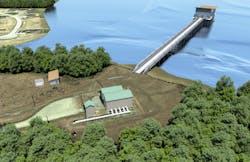Houston team leverages connected data environment for major plant expansion project
By Angela Godwin
With its long history of groundwater extraction, the Houston area found itself with a sinking problem, quite literally. Because of subsidence, the ground had settled as much as 10 feet in some areas of the Houston metropolitan area. “Houston is already subject to flooding so having anything settle and get any lower just makes everything worse,” noted Misti Burkman, PE, BCEE, an environmental engineer and building information modeling (BIM) manager with CDM Smith.
New regulations aimed at halting any future subsidence require Houston to decrease its dependence on groundwater in favor of surface water. By 2035, the city will need to get 80 percent of its water supply from surface water sources.
To meet the challenge, five entities — the city of Houston, the Central Harris County Regional Water Authority, the North Fort Bend Water Authority, the North Harris County Regional Water Authority, and the West Harris County Regional Water Authority — came together on a major treatment plant expansion project that would add 320 MGD of capacity to the Northeast Water Purification Plant, expanding it from 80 MGD to 400 MGD and serving 4.3 million people.
A joint venture between CDM Smith and Jacobs — called the Houston Waterworks Team — is delivering the $1.8-billion-dollar project in what’s been described as the largest progressive design-build project of its kind in the United States.
The team began work on the project in 2015, but it wasn’t until 2017 that design began in earnest, explained Burkman. Because of the project’s sheer size and fairly aggressive timeline (the first 80 MGD is expected to come on-line in 2022 with full commissioning in 2025), the Houston Waterworks Team recognized the need to streamline design work early on. “We’ve got 20 subconsultants on this project — geotechnical engineers, surveyors, architects, stakeholders from the city — all using different tools and having different capabilities,” said Burkman. Based on the design environment, the tools they needed, and some automation work that had already been implemented by Jacobs, the team settled on a suite of design tools from Bentley Systems.
“Bentley has had a long history of providing technology to water and wastewater utilities and supporting the engineering ecosystem of water and wastewater,” said Bob Mankowski, Bentley’s vice president of digital cities. “That includes everything from BIM for water and wastewater treatment plant design to CAD for the documentation and design of assets. There’s a broad spectrum of applications and services that we provide.” This includes ProjectWise, Bentley’s robust design collaboration platform.
“The integration between all of the applications in the Bentley suite with ProjectWise and our automation just seemed like the best choice in this scenario,” said Patrick Porter, BIM manager with Jacobs. “We can control things such as the project standards without having to visit everybody’s machines; we can push those down through ProjectWise itself.” When a new drawing is launched, for example, the changes are automatically pushed out to the rest of the team, he explained.
Before the team could do that, however, everyone had to be trained on the various software tools. “To support the 80-member staff, we had subject matter experts available for every application we used,” said Porter. “On top of that, we did three rounds of training over the course of six months. In the end, we were able to successfully pull it off, despite everybody being new to the program, the software, and our processes.”
Using OpenPlant, OpenBuildings Designer, and MicroStation, the team was able to establish an open, common data environment (CDE) that allowed them to design in context, detect collisions, and optimize design efficiency.
Tasked with designing four parallel water treatment trains, the team was able to leverage the CDE to reduce design time. “We were able to save a total of 4,800 hours for the development of the second phase of the project,” said Porter. “Then we took the first phase that they had already modeled and we copied and replicated that data in the course of about a month to complete the second phase.” As a final step, the designs were then returned to the BIM team for quality assurance. “That delivery method saved us a ton of time as opposed to having to remodel and redesign the second half of the plant,” he added. “And we were able to achieve that because of the integration we set up with the Bentley suite of tools.” WW
Editor’s Note: Because of its creative and successful use of Bentley’s software, which included Bentley Raceway and Cable Management, iModel.js, MicroStation, Navigator, OpenBuildings Designer, OpenPlant, OpenRoads, and ProjectWise, the Houston Waterworks Team earned a well-deserved nomination in Bentley’s 2019 Year in Infrastructure (YII) awards competition in the Water and Wastewater Treatment Plants category.
About the Author: Angela Godwin is editorial director of Endeavor Business Media’s water group of publications.
About the Author

Angela Godwin
Editorial Director
Angela Godwin is the previous editorial director for Endeavor Business Media's Process/Water Group.
